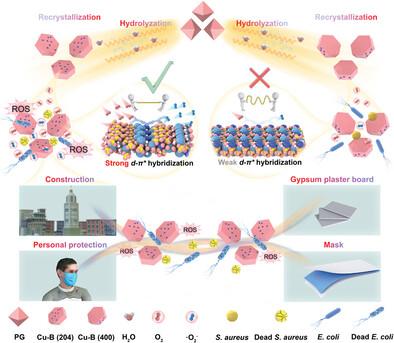当前位置:
X-MOL 学术
›
Adv. Funct. Mater.
›
论文详情
Our official English website, www.x-mol.net, welcomes your
feedback! (Note: you will need to create a separate account there.)
Facet Engineering Modulates d-π* Hybridization for Boosting Antimicrobial Activity
Advanced Functional Materials ( IF 18.5 ) Pub Date : 2024-11-17 , DOI: 10.1002/adfm.202418440 Kun Yu, Huichao Ji, Guangli Ye, Liangjie Fu, Xiongbo Dong, Huaming Yang
Advanced Functional Materials ( IF 18.5 ) Pub Date : 2024-11-17 , DOI: 10.1002/adfm.202418440 Kun Yu, Huichao Ji, Guangli Ye, Liangjie Fu, Xiongbo Dong, Huaming Yang

|
Reactive oxygen species (ROS) have been growing as an emerging “hot” topic in antimicrobial applications. However, optimizing antimicrobial activity by enhancing ROS generation remains a formidable challenge. Here, using bassanite as a proof of concept, the facet engineering of bassanite matrix can enhance the ROS generation efficiency via tuning the d-band center of Cu atom is proposed. Theoretical calculation and experimental investigations reveal that the d-band center of Cu atoms is significantly shifted upward when Cu doped into the (204) facet of bassanite compared to the (400) facet. A higher d-band center facilitates adsorption and activation between Cu and O2 through the formation of stronger d-π* orbital hybridization, resulting in increased ROS production. Through engineering, the material exhibits better antimicrobial activity when Cu doped into the (204) facet, which presents a clear potential in construction materials and personal protection. This work shed light on designing new materials with high antimicrobial activity and the application of facet engineering.
中文翻译:

Facet Engineering 调节 d-π* 杂交以提高抗菌活性
活性氧 (ROS) 已成为抗菌应用中新兴的“热门”话题。然而,通过增强 ROS 的产生来优化抗菌活性仍然是一项艰巨的挑战。在这里,以巴桑石作为概念验证,提出了巴桑石基体的刻面工程可以通过调整 Cu 原子的 d 波段中心来提高 ROS 生成效率。理论计算和实验研究表明,当 Cu 掺杂到巴桑石的 (204) 刻面时,与 (400) 刻面相比,Cu 原子的 d 带中心显着向上移动。较高的 d 带中心通过形成更强的 d-π* 轨道杂化促进 Cu 和 O2 之间的吸附和活化,从而增加 ROS 的产生。通过工程设计,当 Cu 掺杂到 (204) 面时,该材料表现出更好的抗菌活性,这在建筑材料和个人防护方面具有明显的潜力。这项工作阐明了具有高抗菌活性的新材料设计和刻面工程的应用。
更新日期:2024-11-18
中文翻译:

Facet Engineering 调节 d-π* 杂交以提高抗菌活性
活性氧 (ROS) 已成为抗菌应用中新兴的“热门”话题。然而,通过增强 ROS 的产生来优化抗菌活性仍然是一项艰巨的挑战。在这里,以巴桑石作为概念验证,提出了巴桑石基体的刻面工程可以通过调整 Cu 原子的 d 波段中心来提高 ROS 生成效率。理论计算和实验研究表明,当 Cu 掺杂到巴桑石的 (204) 刻面时,与 (400) 刻面相比,Cu 原子的 d 带中心显着向上移动。较高的 d 带中心通过形成更强的 d-π* 轨道杂化促进 Cu 和 O2 之间的吸附和活化,从而增加 ROS 的产生。通过工程设计,当 Cu 掺杂到 (204) 面时,该材料表现出更好的抗菌活性,这在建筑材料和个人防护方面具有明显的潜力。这项工作阐明了具有高抗菌活性的新材料设计和刻面工程的应用。


















































 京公网安备 11010802027423号
京公网安备 11010802027423号